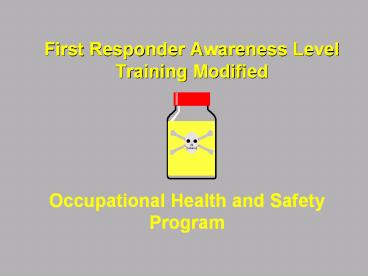First Responder Awareness Level Training Modified - PowerPoint PPT Presentation
1 / 31
Title:
First Responder Awareness Level Training Modified
Description:
Emergency Response Guidebook MSDSs Employees and bystanders North American Emergency Response Guidebook Purpose & Limitations North American Emergency Response ... – PowerPoint PPT presentation
Number of Views:196
Avg rating:3.0/5.0
Title: First Responder Awareness Level Training Modified
1
First Responder Awareness Level Training Modified
Occupational Health and Safety Program
2
Hazardous Materials
- Defined in numerous ways
- Simplified Definition-Any material that, because
of its quantity, concentration, or physical or
chemical characteristics, may pose a real hazard
to human health or the environment.
3
Hazardous Materials Incidents
- Haz-Mat incidents are unique incidents. They
require specialized protective measures not
normally available to first responders AND they
demand a different operational approach!
4
Duty to Act
- Public safety responders have a Duty to Act.
- Level of involvement is defined by employers
Emergency Response Plan (ERP). - NEVER exceed level of training and protection!
5
Five Levels of Training
- First Responder Awareness Level.
- First Responder Operational Level.
- Hazardous Materials Technician.
- Hazardous Materials Specialist.
- Hazardous Materials Incident Commander.
6
Awareness Level Response
- Recognition and Identification
- Isolation
- Protection
- Notification
7
Six Basic Clues to Recognition
- 1 - Occupancy and location.
- 2 - Container shape and size.
- 3 - Placards and labels.
- 4 Material Safety Data Sheets
- 5 - Markings and colors.
- 6 - Human senses.
8
Clue 1 - Occupancy and Location
- Specific occupancy or general area.
- Fixed facilities.
- Five modes of hazardous materials transportation
- Rail, air, marine, highway and pipeline.
9
Clue 2 - Container Shape and Size
- Classifications
- Portable, fixed or transportation.
- Pressure
- Non-pressurized, low or high pressure.
- Vapor Pressure and Storage
- The higher the pressure, the greater the
potential for catastrophic failure. - BLEVE!
10
Clue 3 - Placards and Labels
- Placards and their limitations
- Not always required.
- Placards and labels used for transport are based
upon DOT Hazard Class.
11
Hazard Class 1 - Explosives
- Subdivided into 6 divisions
- 1.1 - Mass explosion hazard
- 1.2 - Projectile hazard
- 1.3 - Fire, minor blast or projectile
- 1.4 - Minor explosion
- 1.5 - Very insensitive explosives
- 1.6 - Extremely insensitive
12
Hazard Class 2 - Gases
- Pressurized or liquefied
- Compressed nitrogen and liquefied petroleum gases
(LPG) are examples. - Product and container present hazards.
- Three Subdivisions
- 2.1 - Flammable gases.
- 2.2 - Non-Flammable, Non-Poisonous.
- 2.3 - Poisonous Gases.
13
Hazard Class 3 - Flammable/Combustible Liquids
- Flammable Liquids-Flash point below 100 degrees
F. - Combustible Liquids-Flash point at or above 100
degrees F. - Number 1 rule- Eliminate ignition sources.
14
Hazard Class 4 - Flammable Solids
- Three subdivisions
- 4.1 - Flammable Solids
- 4.2 - Spontaneously Combustible
- 4.3 - Dangerous when wet
15
Hazard Class 5 - Oxidizers and Organic Peroxides
- Oxidizers release oxygen to enhance or intensify
burn. - With strong fuels, oxidizers can create
conditions which which can lead to violent
combustion. - Many Organic Peroxides are very unstable.
16
Hazard Class 6 - Poisonous and Infectious
Substances
- Poisonous to human
- Can include severely irritating substances.
- Tear Gas, Hydrocyanic acid, Carbon
Tetrachloride. - Infectious Substances
- Potential to cause diseases in humans.
- Anthrax, human blood and many body fluids.
17
Hazard Class 7 - Radioactive Materials
- Ionizing radiation hazard.
- Exposure does not always result in contamination.
- Safety Rules
- Time, Distance and Shielding.
- Shipped in specialized containers.
18
Hazard Class 8 - Corrosives
19
Hazard Class 9 - Miscellaneous Hazardous Materials
- ORM A - Dry Ice
- ORM B - Quick Lime, Metallic mercury
- ORM C - Asphalt, Battery parts
- ORM D - Consumer commodities
- ORM E - Hazardous substances and hazardous wastes
20
Pesticide Labels
- Product name
- Active ingredients
- Signal word
- Caution
- Warning
- Danger (Poison)
- Precautionary statements
21
Clue 4 Material Safety Data Sheets (MSDS)
- Required to be maintained by the Federal Hazard
Communication Standard. - Found at fixed facilities.
- Provides a variety of information.
22
Clue 5 - Markings and Colors
- Container colors are not always standardized.
- NFPA 704 Diamond.
- Military markings.
23
(No Transcript)
24
Clue 6 - Human Senses
High
TASTE TOUCH SMELL SIGHT SOUND
RISK LEVEL
Low
25
Methods of Identification
- Once you recognize, try to identify material
name. - Emergency Response Guidebook
- MSDSs
- Employees and bystanders
26
North American Emergency Response Guidebook
- Purpose Limitations
27
North American Emergency Response Guidebook
- An aid for identification of the material
involved. - Outlines basic initial actions.
- Recommends protective action areas.
- Serves as an initial incident safety plan.
28
Steps for Proper Use of the ERG
- Recognize Identify Hazardous Materials
- Name
- Four digit ID number
- Placard description
- Look up the guide page number.
- Take basic protective actions according to the
guide page. - Initiate isolation and evacuation according to
protective action distances.
29
Basic Protective Actions
- Main Objectives
- Isolate
- Protect by preventing contamination.
- Notify as in Emergency Response Plan.
30
Protective Action Options
- Shelter in-place
- Short duration incidents.
- Greater hazard to attempt to move.
- Impractical to evacuate.
- Evacuation
- Potential for massive fire or explosion.
- Long duration incidents.
31
Thank You For Your Participation
- Be Safe!






























